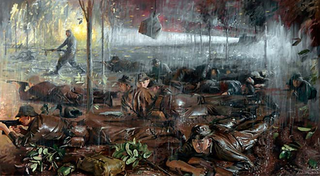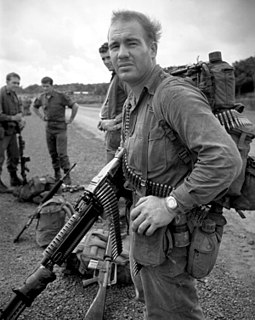
HMAS Sydney (R17/A214/P214/L134) was a Majestic-class light aircraft carrier operated by the Royal Australian Navy (RAN). She was built for the Royal Navy and was launched as HMS Terrible (93) in 1944, but was not completed before the end of World War II. The carrier was sold to Australia in 1947, completed, and commissioned into the RAN as Sydney in 1948.

The Battle of Long Tan took place in a rubber plantation near Long Tân, in Phước Tuy Province, South Vietnam, during the Vietnam War. The action was fought between Viet Cong (VC) and People's Army of Vietnam (PAVN) units and elements of the 1st Australian Task Force.

The 1st Australian Task Force was a brigade-sized formation which commanded Australian and New Zealand Army units deployed to South Vietnam between 1966 and 1972. 1 ATF was based in a rubber plantation at Nui Dat, 8 kilometres (5.0 mi) north of Ba Ria in Phuoc Tuy Province and consisted of two and later three infantry battalions, with armour, aviation, engineers and artillery support. While the task force was primarily responsible for securing Phuoc Tuy Province, its units, and the Task Force Headquarters itself, occasionally deployed outside its Tactical Area of Responsibility.

No. 9 Squadron was a unit of the Royal Australian Air Force (RAAF). The squadron was formed in early 1939 and saw active service in World War II as a fleet co-operation unit providing aircrews for seaplanes operating off Royal Australian Navy cruisers. It was disbanded in late 1944, but was re-raised in 1962 and later became an Army co-operation unit, flying helicopters in support of Australian troops during the Vietnam War. The squadron was disbanded in 1989 when the RAAF transferred its battlefield helicopters to the Australian Army's aviation regiments.

The Battle of Coral–Balmoral was a series of actions fought during the Vietnam War between the 1st Australian Task Force and the North Vietnamese 7th Division and Viet Cong Main Force units, 40 kilometres (25 mi) north-east of Saigon. Following the defeat of the communist Tet offensive in January and February, in late April two Australian infantry battalions—the 1st and 3rd Battalions of the Royal Australian Regiment (RAR)—with supporting arms, were again deployed from their base at Nui Dat in Phước Tuy Province to positions astride infiltration routes leading to Saigon to interdict renewed movement against the capital. Part of the wider allied Operation Toan Thang I, it was launched in response to intelligence reports of another impending communist offensive, yet the Australians experienced little fighting during this period. Meanwhile, the Viet Cong successfully penetrated the capital on 5 May, plunging Saigon into chaos during the May Offensive in an attempt to influence the upcoming Paris peace talks scheduled to begin on the 13th. During three days of intense fighting the attacks were repelled by US and South Vietnamese forces, and although another attack was launched by the Viet Cong several days later, the offensive was again defeated with significant losses on both sides, causing extensive damage to Saigon and many civilian casualties. By 12 May the fighting was over, and the North Vietnamese and Viet Cong were forced to withdraw having suffered heavy casualties. US casualties were also heavy and it proved to be their most costly week of the war.

Australia's involvement in the Vietnam War began with a small commitment of 30 military advisors in 1962, and increased over the following decade to a peak of 7,672 Australian personnel following the Menzies Government's April 1965 decision to upgrade its military commitment to South Vietnam's security. By the time the last Australian personnel were withdrawn in 1972, the Vietnam War had become Australia's longest war, and was only recently surpassed by Australia's long-term commitment of combat forces to the War in Afghanistan. It remains Australia's largest force contribution to a foreign conflict since the Second World War and was also the most controversial in Australian society since the conscription controversy during the First World War. Although initially enjoying broad support due to concerns about the spread of communism in Southeast Asia, a vocal anti-war movement developed in response to Australia's programme of conscription.

The 5th Battalion, Royal Australian Regiment is a regular motorised infantry battalion of the Australian Army. Originally established in 1965 it would serve two tours of South Vietnam before it was linked with the 7th Battalion to form the 5th/7th Battalion, Royal Australian Regiment in 1973. In late 2006 the two units were de-linked, and 5 RAR again joined the Australian Army's order of battle in its own right. It has since served in Iraq, East Timor and Afghanistan.

New Zealand's involvement in the Vietnam War was highly controversial, sparking widespread protest at home from anti-Vietnam War movements modelled on their American counterparts. This conflict was also the first in which New Zealand did not fight alongside the United Kingdom, instead following the loyalties of the ANZUS Pact.

Australian Army Aviation (AAAvn) is a corps of the Australian Army. It was formed on 1 July 1968, although it has a history dating back to 1911, when the Minister of Defence at the time, Senator George Pearce, decided there should be a flying school in the Defence Department. The motto of the Australian Army Aviation corps is Vigilance.
The 1st Close Health Battalion (1CHB) is a unit of the 17th Sustainment Brigade of the Australian Army. It is headquartered at the Robertson Army Barracks in Darwin, but has sub-units located in Darwin, Townsville and Brisbane. The unit traces its lineage back to the 1st Field Hospital, which was raised in the 1960s for service as part of Australia's contribution to the Vietnam War. Since then, the unit has changed names twice and personnel have been deployed on numerous peacekeeping and warlike operations throughout Africa, the Middle East and the Asia-Pacific region.

General Sir John Gordon Noel Wilton, was a senior commander in the Australian Army. He served as Chief of the General Staff (CGS), the Army's professional head, from 1963 until 1966, and as Chairman of the Chiefs of Staff Committee (CCOSC), forerunner of the role of Australia's Chief of the Defence Force, from 1966 until 1970. His eight-year tenure as senior officer of first the Army and then the Australian military spanned almost the entire period of the nation's involvement in the Vietnam War.
The 8th/12th Regiment, Royal Australian Artillery, was formed at the Holsworthy Barracks on 16 November 1973 through the amalgamation of the 8th Medium Regiment (RAA) and the 12th Field Regiment (RAA). The Regiment provides field artillery support to the 1st Brigade based in Darwin. It is currently equipped with 155mm M777 Howitzers.

The Indonesia-Malaysia confrontation was fought from 1962 to 1966 between the British Commonwealth and Indonesia. Indonesia, under President Sukarno, sought to prevent the creation of the new Federation of Malaysia that emerged in 1963, whilst the British Commonwealth sought to safeguard the security of the new state. The war remained a limited one however, and was fought primarily on the island of Borneo, although a number of Indonesian seaborne and airborne incursions into the Malay Peninsula did occur. As part of Australia's continuing military commitment to the security of Malaysia, Australian army, naval and air force units were based there with the Far East Strategic Reserve, mainly in the 28th Commonwealth Infantry Brigade Group.

Operation Coburg was an Australian and New Zealand military action during the Vietnam War. The operation saw heavy fighting between the 1st Australian Task Force and North Vietnamese Army and Viet Cong forces during the wider fighting around Long Binh and Bien Hoa.

The Battle of Suoi Chau Pha was fought during the Vietnam War between Australian troops and the Viet Cong. The battle took place during Operation Ballarat, an Australian search and destroy operation in the eastern Hat Dich area, north-west of Nui Dat in Phuoc Tuy province. Following a covert insertion the day before which had caught a number of Viet Cong sentries by surprise, A Company, 7th Battalion, Royal Australian Regiment had patrolled forward unaware of the presence of a large Viet Cong main force unit nearby. Clashing with a reinforced company from the Viet Cong 3rd Battalion, 274th Regiment, a classic encounter battle ensued between two forces of roughly equal size. Fought at close quarters in dense jungle amid a heavy monsoon rain, both sides suffered heavy casualties as neither was able to gain an advantage. Finally, after a battle lasting several hours, the Australian artillery proved decisive and the Viet Cong were forced to withdraw, dragging many of their dead from the battlefield after having suffered crippling losses.
The 161 (Independent) Reconnaissance Flight was an Australian Army aviation unit of fixed-wing and rotary aircraft. In June 1965, the 161 Reconnaissance Flight was raised part of the No. 16 Army Light Aircraft Squadron based at RAAF Base Amberley for deployment to the Vietnam War. In September that year the flight deployed to South Vietnam with two Cessna 180 planes and two Sioux light observation helicopters in order to support the 1st Battalion, Royal Australian Regiment based at Bien Hoa airbase The unit deployed to Vung Tau on 13 May 1966. The Flight was re-designated the 161 (Independent) Reconnaissance Flight. when unit strength was increased, so making it an Independent unit. Following the expansion of the Australian commitment, the Flight continued to serve in this role as part of the 1st Australian Task Force, with an enlarged, established and expanded responsibilities, operating out of Vung Tau and Nui Dat until the end of 1971 when it was withdrawn to Australia. In March 1967, the 16th Army Light Aircraft Squadron was renamed the 1st Aviation Regiment.
The Battle of Núi Lé was the last major battle fought by Australian and New Zealand forces in South Vietnam. The battle was fought in the former Phước Tuy Province between elements of the People's Army of Vietnam (PAVN) 33rd Regiment and 'B' and 'D' Companies of the 4RAR/NZ (ANZAC) Battalion and during Operation Ivanhoe. Núi Lé, a small hill within Quang Thanh commune in Chau Duc District, is today in Ba Ria-Vung Tau Province.
This is an order of battle listing the Australian and Viet Cong forces involved in the Battle of Long Tan which occurred in Phuoc Tuy Province, South Vietnam on 18 August 1966.
Operation Hardihood was a security operation conducted from 16 May to 8 June 1966 during the Vietnam War by the U.S. 503rd Infantry Regiment, the 1st Battalion, Royal Australian Regiment (1RAR) and the 5th Battalion, Royal Australian Regiment in Phước Tuy Province, South Vietnam to secure the area around Nui Dat for the establishment of a base area for the 1st Australian Task Force.
The Royal New Zealand Infantry Regiment contributed companies to the 1st Australian Task Force in the Vietnam War.
















